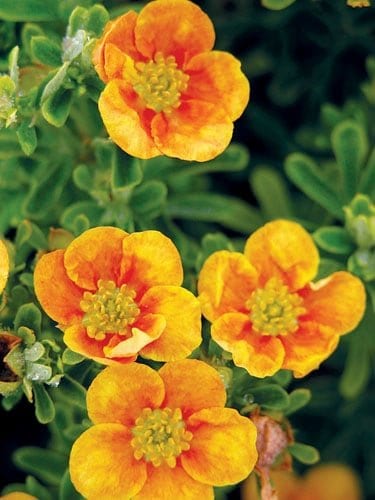
A big beech tree taken down in the front garden last summer has created a gardening opportunity. With greatly increased light and space to be filled, I’m faced with a crisis of selection. The area has high visibility beside the front entrance, and there’s room for three key plants, with additional companions in complementary colours and forms. I want the key plant to be a low shrub with delicate foliage that will flower consistently through summer and early fall. It should also attract butterflies and require no fussy maintenance. So, of course, it’s going to be Mango Tango potentilla (Potentilla fruticosa ‘UMan’)!
I’ll admit to shying away from using potentilla shrubs in high-profile locations. All too often I’ve seen them massed in parking lot island beds, parched in the hot sun and looking limp and ragged. This is often the fate of plants labelled as appropriate for commercial landscape sites, with the assumption that they can be abandoned to every kind of environmental abuse, without benefit of conscientious care. I wouldn’t look very good after spending a summer in a parking lot, and a potentilla shrub fares no better. But with decent soil, regular irrigation and a light pruning in early spring, potentilla is a charming plant with much to offer.
Finding a small shrub that will be constantly in bloom is a tall order. Most flowering shrubs bloom for three to six weeks, not long enough to sustain a good show at my front door. Potentilla begins flowering in early June, just as the spring-flowering shrubs and perennials are finishing, and continues for 12 weeks (or more) until the beginning of the autumn colour show. It’s hard to ignore a plant that provides such an extended period of bloom and is hardy to Zone 3.
I’ve seen an awful lot of lemon-yellow potentillas. Not to cast aspersions on such a pretty shade of yellow, but it’s too predictable in the world of potentillas, and I’d like something with a bit more depth. Fortunately, several bicolour potentillas have been bred at the University of Manitoba, where the hybridizing program has focused on new flower colours and an increased number of petals. Mango Tango is a compact bicolour dwarf shrub, 24 by 24 inches (60 by 60 cm), with masses of flowers with orange-red or burnt sienna centres, radiating to deep squash yellow. It blooms on new growth and can be fertilized and lightly tip-pruned in midsummer to stimulate new flower buds. (More substantial shape pruning is done in early spring by removing up to one-third of the oldest branches.) The colours are deep and rich, and butterflies love it.
I’ve overcome my reservations about potentillas, realizing that giving reasonable attention to a plant produces the best results. Now that I’ve decided on three Mango Tango potentillas for the new garden space, I can begin thinking about appropriate companions – and they’re going to be blue and purple.









Connon Nursery Hwy 9 just west of Newmarket On, east of Hwy 400.
Connon Nurseries have other locations also.
Where can you buy theses been looking all over for them can’t seem to find them anywhere
Costco has them.